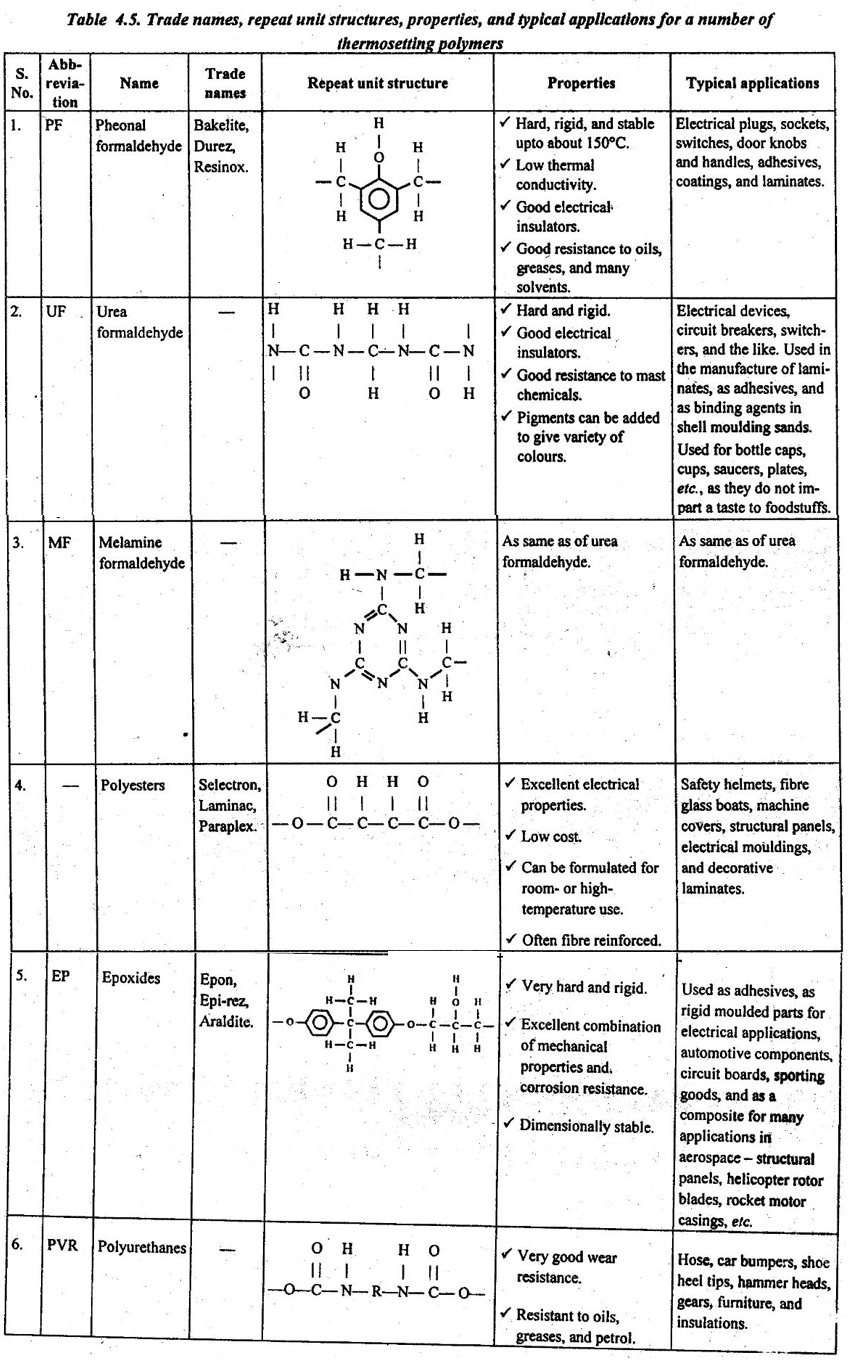Some of the important thermosetting plastics, their trade names, properties, and typical applications are given Table 4.5.
PROPERTIES AND APPLICATIONS OF SOME THERMOSETTING PLASTICS
Some of the important thermosetting plastics, their trade names, properties, and typical applications are given Table 4.5.
Following are some comments about several thermosetting plastics listed in Table 4.5.
1. Phenolics
Phenolics, also known as Bakelites, are the oldest family of thermosetting plastics. The most important phenolic materials is the polyformaldehydes.
1. Polyformaldehyde (PF)
✔ Phenolics are based on phenol and formaldehyde, that's why they are also termed as phenol formaldehydes (PF).
✔ Characteristics of PFs :
1. They are hard, rigid thermosets stable upto about 150°C.
2. They have low thermal conductivity and good electrical insulation properties.
3. They possess good resistance to oils, greases, and many solvents.
4. They are relatively low in cost.
5. They are limited in colourability.
✔ Applications: Typical applications of phenol formaldehydes (PFs) include electrical plugs, sockets, switches, telephones, door knobs and handles, adhesives, coatings, and laminates.
2. Amino-Formaldehyde Materials
These thermoset high polymers contain an amino group (NH2) condensed with aldehydes. The most important of amino- formaldehyde polymers are urea formaldehyde and melamine- formaldehyde.
1. Urea formaldehyde (UF)
✔ Urea formaldehyde is produced by condensing urea monomers with formaldehyde.
✔ Characteristics of UFs :
1. They are similar to the phenolics.
2. They are hard and rigid thermosets.
3. They have good electrical insulation properties.
4. They exhibit good resistance to most chemicals.
5. They are light in colour. However pigments can be added to give a wide range of coloured mouldings.
✔ Applications: Typical applications of UFs include electrical devices, circuit breakers, switches, and the like; used in the manufacture of laminates, as adhesives, and as binding agents in shell moulding sands; for bottle caps, cups, saucers, plates, etc., as they do not impart a taste to food stuffs.
2. Melamine formaldehyde (MF)
✔ Melamine formaldehyde is produced by condensing melamine monomers with formaldehyde.
✔ Characteristics of MFs: The general properties of melamine formaldehyde (MF) materials are similar to those of urea formaldehyde (UF) materials. But the MFs have a better resistance to heat and can be used at temperatures of upto 95°C.
✔ Applications: The MFs are used for many of the same types of applications as the UFs and phenolics.
3. Other Thermosetting Plastics
The other thermosetting polymers are:
1. Polyesters
✔ Polyesters are reaction products of dibasic acids and polyhydric alcohols.
✔ Applications: Typical applications of polyesters include safety helmets, fibre glass boats, machine covers, structural panels, electrica, mouldings, and decorative laminates.
2. Epoxides (EP)
✔ Epoxides are thermosetting polymers formed from molecules containing a tight C-O-C ring.
✔ Applications: Epoxides are used as adhesives, as rigid moulded parts for for electrical applications, automotive components, circuit boards, sporting goods, and as a matrix for fibre-reinforced composite materials for aerospace.
3. Polyurethanes (PUR)
✔ Polyurethane is a family name given to a series of polymers that are produced by the reaction between aromatic di- isocyanates and low molecular weight polymer molecules.
✔ Depending on the degree of formulation, the urethanes behave as thermosetting polymers, thermoplastic polymers, or elastomers.
✔ Applications: Typical applications of polyurethanes include hoses, car bumpers, shoe heel tips, hammer heads, gears, furniture, and insulations.
Note
✔ In addition to thermoplastics and thermosetting plastics, a number of natural and synthetic linear polymers called elastomers are available.
✔ The term elastomer is used to describe a polymer that has rubber like properties.
✔ Elastomers have unique characteristics in that, at room temperature, they can be stretched upto at least twice their original length and upon immediate release of the stress will return quickly to approximately their original length.
✔ The more important engineering elastomers in general as include:
1. Natural rubber (NR),
2. Polyisoprene (IR),
3. Styrene-butadiene rubber (SBR),
4. Butadiene rubber (BR),
5. Polychloroprene rubber (CR),
6. Acrylonitrile-butadiene rubber (NBR),
7. Butyl rubber (IIR),
8. Ethylene-propylene rubber (EPM), and
9. Silicone rubber (SI).

No comments:
Post a Comment